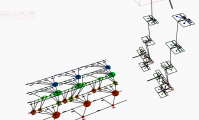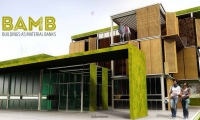Circular material management is a key aspect towards a sustainable built environment. Transformable Design contributes to the reduction of excessive waste generated by maintenance and demolition, through the reuse of building components and materials. Nevertheless, current building practices will only shift towards Transformable Design provided expected (mid or long term) environmental benefits and financial viability. Therefore, there is a need for a usable assessment method considering the lifelong impacts of Transformable Design. Once the user requirements defined through survey analysis, the research will elaborate a method to assess the capacity of building to respond (and be adapted instead of demolished) to transformation and refurbishment needs. On one hand, an algorithm will model the service life of the building through the definition of specific refurbishment scenarios. On another, Transformable Design criteria will be transposed into an algorithmic assessment method. In order to guaranty the objectivity of the overall method and its compatibility with the design process, the elaborated method will be compatible with Building Information Modelling (BIM) and will be implemented into a practical BIM tool, through the use of Autodesk Revit and Dynamo. This tool will be tested on different case studies in order to confirm the validity of the assessment and the relevance of the feedback provided. The designer will be then able to compare different service life models and design scenarios to make better-informed decisions.
Camille Vandervaeren
Camille Vandervaeren
Ir. arch. Camille Vandervaeren is a PhD researcher at the Architectural Engineering Lab of the Vrije Universiteit Brussel (VUB), interested in Circular Material Management, Design for Change and Building Information Modelling (BIM). She obtained the degree of “Master of Sciences in Architectural Engineering” at Bruface (ULB-VUB) in 2016. In her PhD research, started under the supervision of Niels De Temmerman, Waldo Galle and André Stephan, she is developping an assessment tool for Transformable Design, using Building Information Modelling (BIM). She also collaborated on the Horizon2020 Buildings As Material Banks (BAMB) project, towards the valorisation of building elements used in the construction today as resources for the future.
Projects
PhD research
Development of a BIM tool to assess the lifelong impacts of Transformable Design
| Date | 2016 - ... |
| Supervisor | Niels De Temmerman |
| Funds | Research Foundation Flanders - FWO (Strategic Basic) |
Master’s thesis
Development of a BIM Tool for Material Flow Assessment of Adaptable Buildings
| Date | 2015 - 2016 |
| Supervisor | Niels De Temmerman |
Construction, maintenance and demolition of buildings is the first source of waste generation. Half of the materials extracted from earth turns into the construction materials and products. The increasing need for change and upgrading put into question our traditional permanent way of building. The replacement of one building element generally means the demolition of others, due to a lack of adaptability in the initial design. Design for Disassembly (DfD) has the potential to reduce the excessive waste by re-using buildings, building components and materials, by using reversible connection techniques and the selection of reusable materials. Nevertheless, the application of DfD principles is often restrained due to uncertainties regarding its global benefits and financial viability. The master thesis addresses this lack of information, by providing designers and clients a tool to support the decision process, regarding the cost and benefits of adaptable design. The developed tool, called MATRx, performs scenario-based assessments of the capacity of a building to recover materials for reuse. The scope and means of the assessment are gradually defined through a review of the existing methods and criteria to Design for Disassembly.
MATRx determines the reuse potential of materials assembled in sequence, according to their durability and the type of connecting elements, and couples this assessment with a Material Flow Analysis (MFA). The effects of the building refurbishment are measured in terms of materials added and evacuated (in mass). DfD impacts on the reuse on site, which does not contribute to the addition nor evacuation of building materials. In MATRx, all interventions experienced by the building are taken into account. While past and present interventions are clearly quantifiable, a ‘Replacement Rate’ factor estimates the future ones. The cost and benefits of different design scenarios are thus assessed from a life cycle perspective.
MATRx is in this research implemented in the Building Information Modeling (BIM) software Revit with the Dynamo add-in. The tool obtained is tested on design case studies including the reconversion of the S-Building of the ULB Solbosh Campus. MATRx provides a basis for a clear, objective and universal assessment, but also a ‘learning’ support giving insights on which are the key parameters for recovering materials. Finally, MATRx must be seen as a first attempt to objectivise the DfD criteria. Its development is limited due to lack of available data on how technical products suit reuse on multiple life cycles. Nevertheless, the ongoing elaboration of material database suggests further development of tools such MATRx, which may be the interest of a range of construction actors, from architects, property developers, to constructors and policy makers.
Awards
ISCOWA Award 2018
| Date | 2018 |
ISCOWA Award 2018 for the best witten and presented paper by an author under 35 years of age at the WASCON 2018 conference - 10th International Conference on the Environmental and Technical Implications of Constrction with Alternative Materials.
Title of the publication: "MATRx, development of a materia flow assessment tool for Design for Disassembly"
https://www.linkedin.com/feed/update/urn:li:activity:6410810155453292544



_TH_150x450.png)